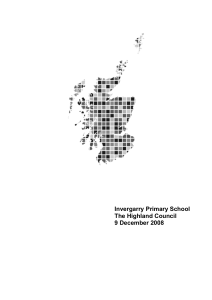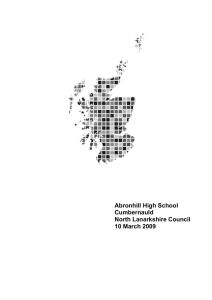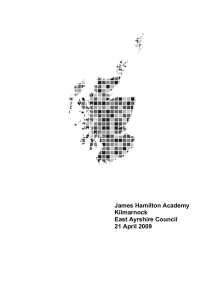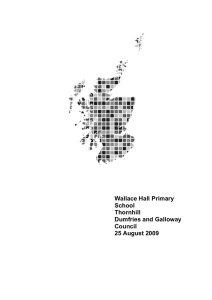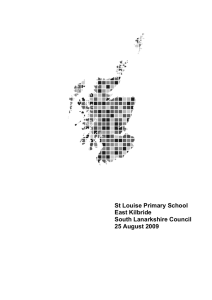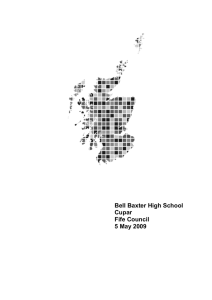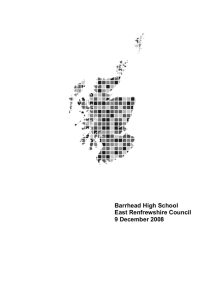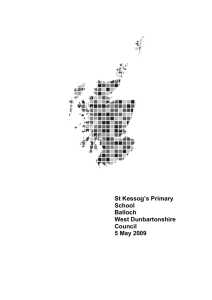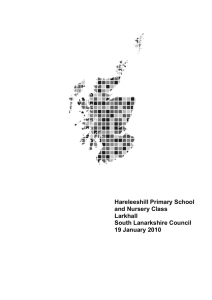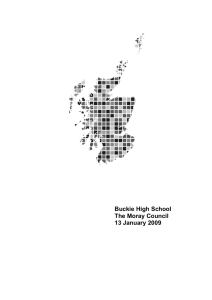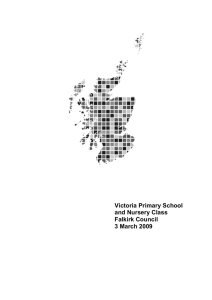Dalserf Primary School Ashgill South Lanarkshire Council
advertisement
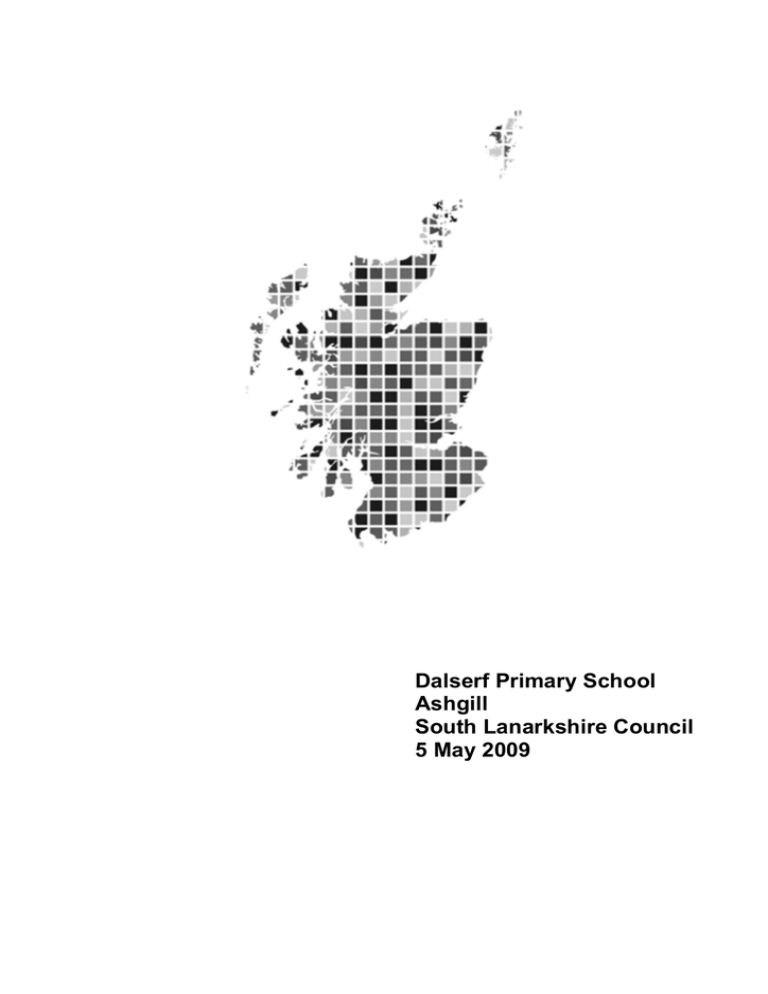
Dalserf Primary School Ashgill South Lanarkshire Council 5 May 2009 This report tells you about the quality of education at the school. We describe how children benefit from learning there. We explain how well they are doing and how good the school is at helping them to learn. Then we look at the ways in which the school does this. We describe how well the school works with other groups in the community, including parents1 and services which support children. We also comment on how well staff and children work together and how they go about improving the school. Our report describes the ‘ethos’ of the school. By ‘ethos’ we mean the relationships in the school, how well children are cared for and treated and how much is expected of them in all aspects of school life. Finally, we comment on the school’s aims. In particular, we focus on how well the aims help staff to deliver high quality learning, and the impact of leadership on the school’s success in achieving these aims. If you would like to learn more about our inspection of the school, please visit www.hmie.gov.uk. Here you can find analyses of questionnaire returns. Where applicable, you will also be able to find descriptions of good practice in the school. 1 Throughout this report, the term ‘parents’ should be taken to include foster carers, residential care staff and carers who are relatives or friends. Contents 1. The school 2. Particular strengths of the school 3. How well do children learn and achieve? 4. How well do staff work with others to support children’s learning? 5. Are staff and children actively involved in improving their school community? 6. Does the school have high expectations of all children? 7. Does the school have a clear sense of direction? 8. What happens next? 1. The school Dalserf Primary school is a non-denominational school. It serves the village of Ashgill and surrounding areas of South Lanarkshire. The roll was 82 when the inspection was carried out in March 2009. Children’s attendance was in line with the national average in 2007/08. 1 2. Particular strengths of the school • The effective leadership of the new headteacher. • A caring and nurturing environment for children. • High attainment in mathematics. • The commitment of all staff to improving learning and teaching. 3. How well do children learn and achieve? Learning and achievement Children are motivated and keen to learn. They engage well in almost all their lessons, working individually and in pairs. Children respond positively to their teacher’s questioning and advice about how to improve their learning. They show good citizenship skills through their involvement in buddying, working as paired readers, charity work and taking on responsibilities in classroom tasks. They are confident and effective contributors and show this in their work with the local church, in enterprise activities, and in a wide range of after-school and lunch-time clubs. Children at the early stages benefit from being actively involved in their learning. Staff should build on this good practice. Children’s listening and talking skills are progressing well at the early stages. Children in the upper stages need more opportunity to develop their listening and talking. Almost all children make good progress in their reading and a few achieve national assessment levels early. The majority of children can write well in a range of styles and for different purposes. Their progress is slower and more variable in writing. In mathematics, almost all children make good progress from their prior levels of attainment and achieve well in national assessments. The majority of children do well in solving mathematical problems and would benefit from more opportunities to practise these 2 skills. A significant number of children would benefit from greater challenge and a faster pace of teaching and learning. Curriculum and meeting learning needs Children across the school enjoy a broad curriculum. Children in the early stages have opportunities to choose activities which match how they learn best. Older children would benefit from more choice. Staff plan programmes that help to develop children’s skills in citizenship, enterprise, health and wellbeing, and the arts. They are reviewing personal and social education programmes to reflect more current thinking. Teachers are beginning to review the curriculum to provide more challenge and to better reflect the aims of the Curriculum for Excellence. Children are learning French well in P6/P7. They benefit from at least one and a half hours of high quality physical education each week. The curriculum is improved by the input of the active schools coordinator for physical education, by visiting specialist teachers in music, and by outings and visiting drama groups. Children are developing skills using information and communications technology (ICT) in the classroom and in timetabled ICT lessons. Interactive whiteboards are used to reinforce some aspects of children’s learning. Children would benefit from more opportunity to develop their ICT skills in a wider range of classroom activities. Staff are beginning to consider more opportunities to extend literacy and numeracy across the curriculum. Tasks and activities are generally well matched to children’s needs. The majority of children know when they are doing well and when they need help to improve their learning. Children are given some choice in their learning and enjoy taking responsibility for their learning. A small number of children require more challenge particularly when they are involved in independent learning. Children’s individual learning needs are not always well identified. Planning to meet the needs of children with additional support needs is not sufficiently individualised. Learning targets are not set and children’s progress should be monitored in a more regular and systematic way. 3 Children with additional support needs would benefit from further development of resources and teaching approaches to better meet their needs. 4. How well do staff work with others to support children’s learning? The school has developed good links with the local community and the new headteacher has strengthed these further. Children’s understanding of different faiths is enhanced by the involvment of the church youth worker who plays an active part in some school assemblies. The school provides very good support to parents through the home-school partnership officer who runs a number of classes to develop parents’ skills. These include, for example, cooking and managing children’s behaviour. She also supports children’s mathematical learning by her involvment in workshops for parents who have children in P1 to P4. Parents are actively involved in the parent-teacher association, which is soon to merge with the Parent Council. They help to fund raise and hold regular coffee mornings in the school. Specialist services such as occupational therapy, nursing and eduational psychology provide good support for children with additional support needs. A small number of children with significant learning difficulties have regular reviews and helpful multi-agency advice . The school is in the process of preparing individual education plans or additional support plans for them. The support for learning teacher helps to assess and work with individual children. Futher work is needed to ensure that the support provided by additional support staff and specialists is planned effectively and integrated into everyday classroom teaching. The school deals well with parental complaints and keeps an ongoing log to monitor recurring issues. 4 5. Are staff and children actively involved in improving their school community? The pupil council has been given a higher profile and is now actively involved in running council meetings and consulting with children to make improvements to the school. Children’s views are sought about a range of issues. These include the tuck shop and healthy eating alternatives, playground activities and how two hours of physical education could be delivered. Staff have recently been involved in working groups to take forward priorities in the school improvement plan. They have also been involved in evaluating their performance in key areas of teaching and learning and in the vision, values and aims for the school. They now need to think more about how they gather and use the information to decide on priorities for making the school better. The school has been successful in taking forward the majority of its school improvement priorites, particualrly in the area of health. 6. Does the school have high expectations of all children? The school provides a very caring and nurturing environment where children thrive. There is a strong sense of community. Children like to share their own successes and generously praise those of others. All staff have high expectations of children’s behaviour and attendance. Children report that they are treated fairly and with respect. Buddies in P7 help younger children to feel safe and provide a good example for all children to follow. Children’s achievements both in and out of school are celebrated in assemblies and displayed around the school. Staff use rewards well both in and out of class to praise children and to encourage them to work harder and achieve more. Children are learning about the environment and how to treat it with respect through their eco activities. All staff are aware of how to keep children safe. 5 7. Does the school have a clear sense of direction? The newly appointed headteacher has provided the school with a shared vision and clear sense of direction. She has identified a number of priorities to further improve learning and teaching. Staff have a clearer understanding of how to improve as a result of helpful advice from the headteacher about their forward plans. Further improvements in learning and teaching would be enhanced by sharing good practice. Children have been given stronger roles and responsibilities and are now taking a more active part in school improvement. A wide range of stakeholders are consulted and their views have been used to inform future developments. All staff and the headteacher are strongly committed to making the school better. 8. What happens next? We are confident that the school will be able to make the necessary improvements in light of the inspection findings. As a result, we will make no more visits following this inspection. The school and the education authority will inform parents about the school’s progress in improving the quality of education. 6 We have agreed the following areas for improvement with the school and education authority. • Improve the curriculum in line with the principles of Curriculum for Excellence to provide more varied and challenging learning experiences. • Develop better systems for the identification, planning and monitoring of children’s progress, particularly for children with additional support needs. • Develop a more systematic and robust approach to identifying and taking forward areas for school improvement. 7 Quality indicators help schools and nursery classes, education authorities and inspectors to judge what is good and what needs to be improved in the work of a school and a nursery class. You can find these quality indicators in the HMIE publications How good is our school? and The Child at the Centre. Following the inspection of each school, the Scottish Government gathers evaluations of three important quality indicators to keep track of how well all Scottish schools and nursery classes are doing. Here are the evaluations for Dalserf Primary School. Improvements in performance Learners’ experiences Meeting learning needs good good satisfactory We also evaluated the following aspects of the work of the school. The curriculum Improvement through self-evaluation HM Inspector: Laura-Ann Currie 5 May 2009 8 satisfactory satisfactory To find out more about inspections or get an electronic copy of this report go to www.hmie.gov.uk. Please contact the Business Management and Communications Team (BMCT) if you wish to enquire about our arrangements for translated or other appropriate versions. If you wish to comment about any of our inspections, contact us at HMIEenquiries@hmie.gsi.gov.uk or alternatively you should write in the first instance to BMCT, HM Inspectorate of Education, Denholm House, Almondvale Business Park, Almondvale Way, Livingston EH54 6GA. Our complaints procedure is available from our website www.hmie.gov.uk or alternatively you can write to our Complaints Manager, at the address above or by telephoning 01506 600259. If you are not satisfied with the action we have taken at the end of our complaints procedure, you can raise your complaint with the Scottish Public Services Ombudsman (SPSO). The SPSO is fully independent and has powers to investigate complaints about Government departments and agencies. You should write to SPSO, Freepost EH641, Edinburgh EH3 0BR. You can also telephone 0800 377 7330, fax 0800 377 7331 or e-mail: ask@spso.org.uk. More information about the Ombudsman’s office can be obtained from the website at www.spso.org.uk. This report uses the following word scale to make clear judgements made by inspectors. excellent very good good satisfactory weak unsatisfactory outstanding, sector leading major strengths important strengths with some areas for improvement strengths just outweigh weaknesses important weaknesses major weaknesses Crown Copyright 2009 HM Inspectorate of Education
